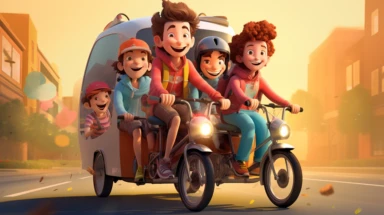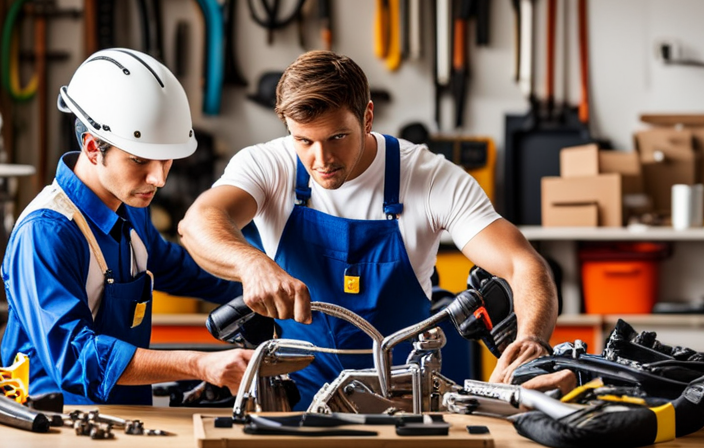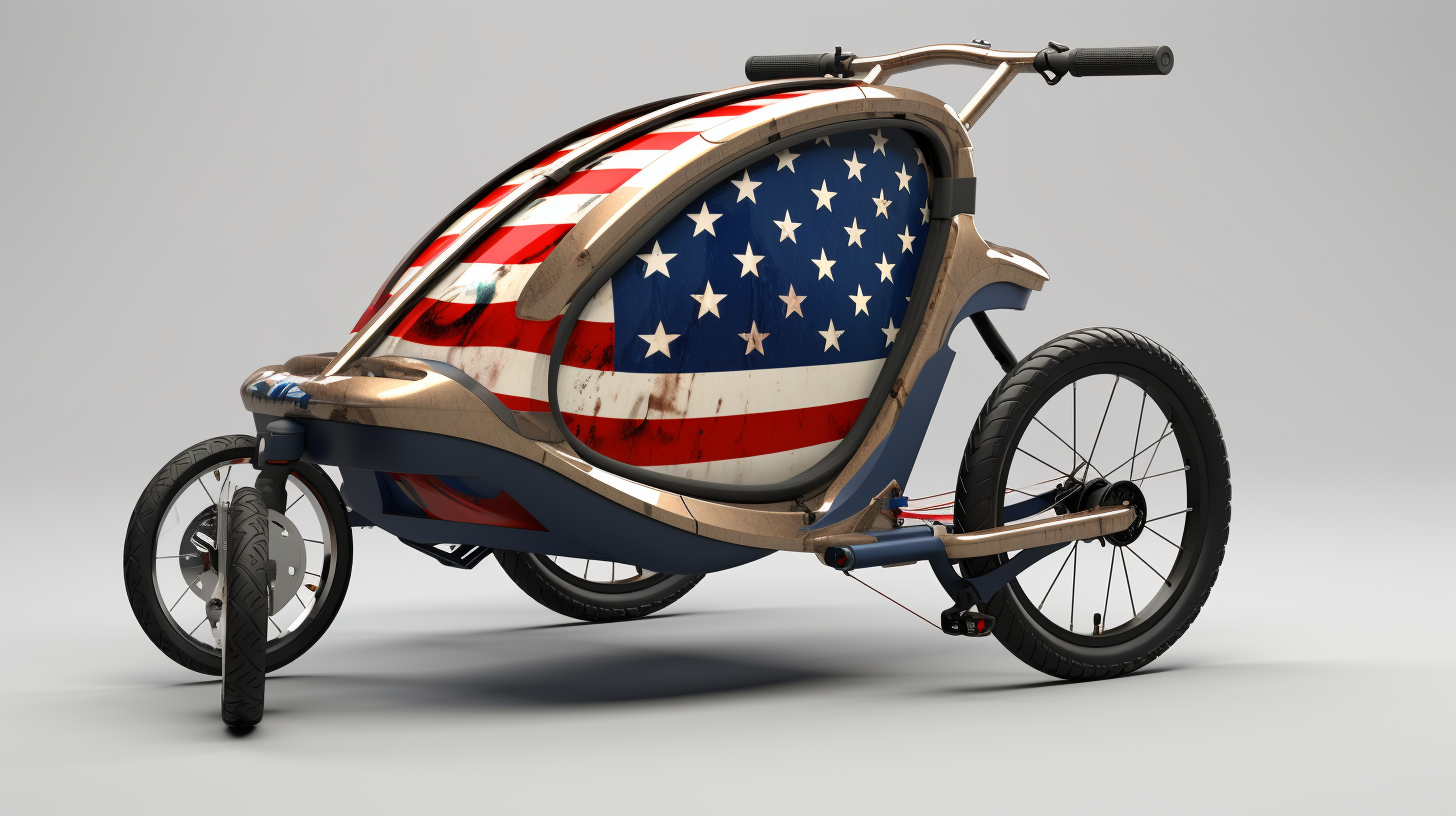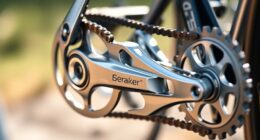As a passionate cyclist and parent, I have always placed a strong emphasis on safety and durability when selecting a bike trailer for my children.
In my search for a trailer comparable to the renowned Burley brand, I have discovered several companies that offer exceptional options. Thule, Allen Sports, Schwinn, InStep, ClevrPlus, and Retrospec are just a few of the top contenders.
Join me as we delve into the world of kids bike trailers and explore the features and benefits offered by these reputable brands.
Key Takeaways
- Thule, Allen Sports, Schwinn, InStep, ClevrPlus, and Weehoo are reputable brands that offer kids bike trailers comparable to Burley.
- These brands prioritize safety and durability with secure harness systems, sturdy frames, and reflective materials for increased visibility.
- Budget-friendly options are available from several brands, providing affordable bike trailers without compromising on safety and quality features.
- Each brand has its own strengths and advantages, so it’s important to consider individual preferences and needs when choosing a kids bike trailer.
Thule
Thule makes kids bike trailers that are comparable to Burley. When it comes to comparing Thule and Burley kids bike trailers, there are some notable differences to consider.
Thule offers a range of high-quality trailers with various features and styles to meet different needs. One advantage of Thule trailers is their sleek and modern design, which appeals to many parents. Another pro is the ease of assembly and disassembly, making it convenient for transportation and storage. Thule bike trailers also have excellent safety features, including a secure harness system and reflective materials for increased visibility.
On the downside, some users have reported that Thule trailers can be more expensive than Burley. Additionally, while Thule trailers are generally durable, some have found the fabric to be less resistant to wear and tear over time.
Overall, Thule offers a solid alternative to Burley, providing a reliable and stylish option for parents looking for a kids bike trailer.
Moving on to the next brand, let’s delve into the world of Allen Sports.
Allen Sports
You can find Allen Sports bike trailers that are similar to Burley ones. Allen Sports is a reputable company that offers a range of bike trailers designed for parents and children who enjoy cycling together. While Burley is known for its high-quality and innovative trailers, Allen Sports provides a more affordable option without compromising on safety and features.
One popular Allen Sports bike trailer is the Allen Sports Deluxe Steel Child Trailer. It offers seating for two children and has a maximum weight capacity of 100 pounds. The trailer features a durable steel frame, a weather-resistant canopy, and a large storage area for your essentials. It also includes a foot guard to protect your children’s feet and a safety harness to keep them secure.
| Feature | Allen Sports Deluxe Steel Child Trailer |
|---|---|
| Seating | Two children |
| Weight Limit | 100 pounds |
| Frame Material | Steel |
| Canopy | Weather-resistant |
| Storage | Large storage area |
While Allen Sports may not offer the same range of models and accessories as Burley or Thule, they provide a reliable option for parents seeking a budget-friendly bike trailer. With its sturdy construction, comfortable seating, and safety features, an Allen Sports trailer can provide a fun and enjoyable biking experience for you and your little ones.
Speaking of other options, let’s transition into the next section about Schwinn bike trailers.
Schwinn
When it comes to affordable bike trailers for families, Schwinn offers a range of options with features that cater to different needs. Schwinn kids bike trailers are known for their durability, safety, and comfort.
Compared to Burley, Schwinn trailers are generally more budget-friendly, making them a popular choice for families on a tight budget. One of the key differences between Schwinn and Burley trailers is the weight capacity. Schwinn trailers typically have a lower weight capacity, ranging from 40 to 100 pounds, depending on the model. This makes them ideal for younger children or smaller riders.
Another notable feature of Schwinn bike trailers is their easy assembly and folding mechanism, allowing for convenient storage and transportation. Additionally, Schwinn trailers often come with adjustable seats, harnesses, and protective canopies to ensure a comfortable and safe ride for your little ones.
InStep
If you’re looking for a budget-friendly option for your family’s bike adventures, InStep offers a range of affordable bike trailers with features that cater to different needs.
Here are a few reasons why InStep bike trailers are a great choice for kids:
- Safety: InStep bike trailers are designed with safety as a top priority. They come equipped with secure harness systems and sturdy frames to keep your child safe and protected during rides.
- Comfort: These trailers are designed with comfort in mind, providing padded seats and a smooth ride for your little one. They also have ample storage space for snacks, toys, and other essentials.
- Versatility: InStep offers a variety of bike trailers to choose from, including single and double trailers. This allows you to select the right size and configuration based on your family’s needs.
- Easy to Use: InStep bike trailers are user-friendly and easy to attach to your bike. They also fold up compactly for convenient storage and transport.
When choosing the right InStep bike trailer for your child, consider factors such as their age, weight, and any specific features you may need. Overall, InStep bike trailers provide a reliable and affordable option for family bike adventures.
ClevrPlus
The ClevrPlus bike trailer offers a spacious and comfortable ride for your child. It has a roomy interior, providing ample space for your little one to sit or even take a nap during longer rides. The trailer also boasts a sturdy and durable construction, ensuring your child’s safety and security while on the road.
In terms of benefits, the ClevrPlus bike trailer offers a smooth and stable ride. It has a suspension system and large wheels, which ensure a comfortable experience for both you and your child, even on bumpy or uneven terrains. The trailer also comes with a weather shield, protecting your child from rain or strong winds, and a bug screen, keeping pesky insects at bay.
When comparing the ClevrPlus bike trailer to other kids bike trailers, it stands out for its affordable price point without compromising on quality. It offers many of the same features as more expensive options on the market, making it a great value for money choice. Its easy assembly and foldable design also make it convenient to transport and store when not in use.
Now, let’s move on to discussing the Weehoo bike trailer, which offers a unique riding experience for both you and your child.
Weehoo
Moving on from the ClevrPlus bike trailer, let’s dive into another popular option: Weehoo.
As someone who has extensively researched kids bike trailers, I can confidently say that Weehoo offers a range of benefits that make it a worthy competitor to Burley.
One of the main advantages of Weehoo is its unique design, which allows the child to actively participate in the biking experience. Unlike traditional trailers where the child is simply a passenger, Weehoo trailers have pedals that the child can use to contribute to the ride. This not only promotes physical activity but also fosters a sense of independence and engagement.
In terms of comparison with Burley, Weehoo trailers are generally more compact and lightweight. This makes them easier to maneuver, especially in tight spaces or when going uphill. Additionally, Weehoo trailers have a lower center of gravity, providing enhanced stability and balance.
Another notable feature of Weehoo trailers is their quick and easy attachment system, allowing for effortless installation and removal. This is particularly convenient for parents who frequently switch between using the trailer and riding solo.
Now, let’s transition to the next option in our exploration of kids bike trailers: Hamax.
Hamax
When considering Hamax, you’ll find that their bike trailers offer innovative features that prioritize safety and comfort for your child. Hamax is a brand that competes with Burley in the market for kids bike trailers. Both brands are known for their high-quality products, but they have some key differences in terms of features and design.
One of the main factors to consider when comparing Hamax and Burley is the safety features they offer. Both brands prioritize safety and have features such as a sturdy frame, reliable harness system, and reflective materials for increased visibility. However, Hamax takes safety a step further by incorporating a unique braking system that provides excellent control and stability, even on steep terrain.
In terms of comfort, both Hamax and Burley offer spacious and well-padded seating areas for your child. However, Hamax stands out with its adjustable suspension system, which allows for a smoother ride, especially on rough roads or trails. This feature ensures that your child remains comfortable and protected from vibrations during the ride.
Overall, when comparing the safety features and comfort of Hamax and Burley kids bike trailers, both brands offer excellent options. However, if you prioritize advanced braking and adjustable suspension for a smoother ride, Hamax might be the better choice for you.
Now, let’s transition to the subsequent section about Aosom, another brand that offers kids bike trailers with unique features.
Aosom
Aosom offers a variety of innovative features in their bike trailers that prioritize safety and comfort for your child. With their high-quality construction and thoughtful design, Aosom bike trailers provide a reliable and enjoyable way to transport your little one on your biking adventures.
Here are some advantages of Aosom bike trailers for kids:
- Sturdy and durable frame: Aosom bike trailers are built with a strong and sturdy frame that can withstand the rigors of the road, ensuring the safety of your child.
- Comfortable seating: The seats in Aosom bike trailers are designed to provide maximum comfort for your child, with padded cushions and adjustable straps to securely hold them in place.
- Convenient storage: Aosom bike trailers come with spacious storage compartments, allowing you to bring along snacks, toys, and other essentials for your child.
When choosing the right Aosom bike trailer for your child, consider factors such as the trailer’s weight capacity, safety features like a five-point harness system, and additional features like a sunshade or a rain cover. By carefully considering these factors, you can ensure that you select the perfect Aosom bike trailer that meets your child’s needs.
Transitioning to the subsequent section about Pacific Cycle, another company that offers kids bike trailers…
Pacific Cycle
Pacific Cycle, a leading manufacturer in the industry, offers a wide range of high-quality bike trailers designed to provide a safe and comfortable riding experience for your child. These kids bike trailers from Pacific Cycle come with a variety of features and benefits that make them stand out from other brands in the market.
One notable feature of Pacific Cycle bike trailers is their sturdy construction. They are built with durable materials that ensure long-lasting performance. Additionally, these trailers are equipped with safety harnesses and padded seats to keep your child secure and comfortable during rides.
Another great advantage of Pacific Cycle kids bike trailers is their versatility. Many models come with a convertible design that allows them to be used as strollers or joggers as well. This flexibility makes them ideal for families who enjoy multiple outdoor activities.
When it comes to comparing the price range of Pacific Cycle kids bike trailers with other brands, Pacific Cycle offers competitive pricing without compromising on quality. Their trailers provide excellent value for money, offering the same features and functionality as higher-priced options.
Transitioning into the subsequent section about ‘Schwinn’, it is important to note that while Pacific Cycle offers a wide range of high-quality bike trailers, Schwinn also has a reputation for producing reliable and well-designed kids bike trailers.
Schwinn
Transitioning to Schwinn, it’s worth noting that their reputation for reliability and well-designed products makes them a strong competitor in the market. When comparing features between Schwinn and Burley kids bike trailers, there are some notable differences.
To provide a clear comparison, let’s take a look at the table below:
| Features | Schwinn Kids Bike Trailers | Burley Kids Bike Trailers |
|---|---|---|
| Weight Limit | Up to 100 lbs | Up to 75 lbs |
| Number of | 1 or 2 | 1 or 2 |
| Children | ||
| Storage | Ample storage space | Limited storage space |
| Trailer | Yes | Yes |
| Convertible | Yes | Yes |
| Stroller | Yes | Yes |
| Jogging | Yes | Yes |
| Kit |
Pros of Schwinn kids bike trailers include their higher weight limit, allowing for larger children or more cargo. They also offer ample storage space, making it convenient for longer rides or trips. Additionally, Schwinn trailers are convertible, meaning they can easily transform into strollers or jogging companions.
However, there are a few cons to consider. Schwinn bike trailers tend to be heavier, which might be a drawback for some users. Also, their storage space is greater, but this can result in a larger overall size, potentially making it less maneuverable in certain situations.
In conclusion, Schwinn offers a strong alternative to Burley with their reliable and well-designed kids bike trailers. While they have some pros and cons, their versatile features make them a solid choice for families on the go.
Transitioning to the subsequent section about ‘bell,’ it’s worth mentioning the importance of bike accessories for added safety and convenience.
Bell
When it comes to bells for your bicycle, it’s important to choose one that is loud and easily heard by others on the road. But did you know that Bell, the well-known brand for bike accessories, also offers bike trailers for kids?
Bell bike trailers are a popular choice among parents who are looking for a safe and comfortable way to transport their children while cycling. When comparing Bell bike trailers to Burley trailers, durability is often a concern. While Burley is known for its high-quality and long-lasting trailers, Bell bike trailers hold their own in terms of durability. They are made with sturdy materials and designed to withstand the rigors of everyday use.
In terms of features and performance, Bell bike trailers offer a range of options to cater to different needs. They come with spacious seating areas, adjustable harness systems, and ample storage space. Some models even have additional features like weather shields and bug screens to provide extra protection for your little ones.
If safety and comfort are your top priorities, Thule and Bell are two brands worth considering. Thule kids bike trailers are known for their excellent safety features, including a full roll cage and five-point harness system. Bell bike trailers also prioritize safety with features like reflective materials and secure attachment systems.
Transition: Now that we’ve discussed Bell bike trailers, let’s move on to another popular option, the Burley Bee.
Burley Bee
The Burley Bee is a popular choice among parents looking for a reliable and affordable bike trailer option. With its sturdy construction and thoughtful design, the Burley Bee offers several advantages over other kids bike trailers on the market.
One of the key advantages of the Burley Bee is its durability. Made with high-quality materials, this bike trailer can withstand the wear and tear of regular use. Whether you’re going on a short ride or embarking on a longer adventure, the Burley Bee will keep your child safe and secure.
Another advantage of the Burley Bee is its affordability. Compared to other bike trailers in its class, the Burley Bee offers great value for money. You don’t have to break the bank to provide your child with a safe and enjoyable biking experience.
When choosing a kids bike trailer, it’s important to consider your specific needs and preferences. Here are a few tips to help you make the right choice:
- Consider the weight and size of the trailer. Ensure it can comfortably accommodate your child and any additional gear you may need to bring along.
- Look for safety features such as a five-point harness and a sturdy frame. The Burley Bee excels in these areas, providing peace of mind for parents.
- Check the ease of use, including how easy it is to attach and detach the trailer from your bike. The Burley Bee’s hitch system makes it a breeze to set up and detach.
Transition: Now that we’ve explored the advantages of the Burley Bee, let’s turn our attention to another popular kids bike trailer option: Retrospec.
Retrospec
If you’re looking for a budget-friendly option, Retrospec offers a variety of affordable bike trailers for you to choose from. When comparing Retrospec to Burley, there are a few features and benefits that make Retrospec stand out.
One of the main advantages is the price point. Retrospec trailers are significantly more affordable than Burley trailers, making them a great option for those on a tight budget. Despite the lower price, Retrospec trailers still offer a durable and reliable construction.
Customer reviews and ratings of Retrospec kids bike trailers are generally positive. Many customers appreciate the affordability of these trailers without compromising on quality. They often mention how easy it is to assemble and attach the trailer to their bikes. The trailers are also praised for their smooth ride and comfortable seating for the little ones. Some reviewers have even compared the performance of Retrospec trailers to higher-end brands like Burley, highlighting the impressive value for money.
Transitioning into the subsequent section about ‘instep sync’, it’s worth noting that Retrospec offers a similar type of bike trailer called the Retrospec Sync. This trailer is designed with a focus on safety and convenience, featuring a secure attachment system and ample storage space.
Instep Sync
For an alternative option, you might consider the Instep Sync bike trailer.
When comparing the Instep Sync and Burley bike trailers, there are some key differences to consider.
The Instep Sync is a more budget-friendly option, making it a great choice for those looking to save money. It features a steel frame construction, providing durability and stability on the road. The trailer has a maximum weight capacity of 80 pounds, allowing it to accommodate two children comfortably. It also includes a 5-point safety harness system to ensure your little ones are secure during the ride.
One advantage of the Instep Sync is its easy assembly process, which can be completed in just a few minutes. However, there are a few downsides to using the Instep Sync. Some users reported that the trailer lacks storage space, making it difficult to carry extra items. Additionally, the trailer may not provide as smooth of a ride as the Burley models.
Overall, the Instep Sync is a reliable and affordable option for those looking to take their kids biking.
Moving on to the next option, the Schwinn Joyrider bike trailer…
Schwinn Joyrider
Looking for a more premium option? You might want to check out the Schwinn Joyrider bike trailer. This high-quality trailer offers a range of features and benefits that make it a top choice for families on the go.
One of the standout features of the Schwinn Joyrider is its durable construction. The frame is made from lightweight aluminum, ensuring both strength and stability. The trailer also features 20-inch pneumatic tires, providing a smooth and comfortable ride for your little one.
Safety is a top priority with the Schwinn Joyrider. It is equipped with a 5-point harness system, ensuring your child stays securely in place during your ride. There is also a weather shield that protects your child from the elements, and a bug screen to keep pesky insects out.
When comparing the Schwinn Joyrider to other kids bike trailers, it stands out for its premium features and attention to detail. While it may come with a higher price tag, the durability and added safety features make it worth the investment.
Frequently Asked Questions
What are the weight limits for the Thule, Allen Sports, Schwinn, InStep, ClevrPlus, Weehoo, Hamax, Aosom, Pacific Cycle, Schwinn, Bell, and Burley Bee bike trailers?
The weight limits for kids bike trailers vary depending on the brand and model. Thule, Allen Sports, Schwinn, InStep, ClevrPlus, Weehoo, Hamax, Aosom, Pacific Cycle, Bell, and Burley Bee are all popular options.
It’s important to check the specifications for each specific trailer, as weight limits can range from 40 to 100 pounds. When comparing these trailers to Burley, it’s worth considering factors such as durability, safety features, and overall design.
Are the Thule, Allen Sports, Schwinn, InStep, ClevrPlus, Weehoo, Hamax, Aosom, Pacific Cycle, Schwinn, Bell, and Burley Bee bike trailers foldable for easy storage?
Yes, the Thule, Allen Sports, Schwinn, InStep, ClevrPlus, Weehoo, Hamax, Aosom, Pacific Cycle, Bell, and Burley Bee bike trailers are all foldable for easy storage. They are designed to be compact and convenient when not in use.
Additionally, besides these brands, there are other options available in the market that offer foldable kids bike trailers.
As for the Burley Bee bike trailer, there are various additional features and accessories available, such as rain covers, storage compartments, and sunshades.
Do the Thule, Allen Sports, Schwinn, InStep, ClevrPlus, Weehoo, Hamax, Aosom, Pacific Cycle, Schwinn, Bell, and Burley Bee bike trailers have a rain cover included?
Yes, the Thule, Allen Sports, Schwinn, Instep, ClevrPlus, Weehoo, Hamax, Aosom, Pacific Cycle, Schwinn, Bell, and Burley Bee bike trailers do have a rain cover included.
However, if you are looking for alternative rain covers, there are a few options available. Other companies that make kids bike trailers similar to Burley include Thule, Schwinn, and Instep. These companies offer a range of bike trailers with rain covers that provide protection from the elements.
Are there any specific safety features unique to the Thule, Allen Sports, Schwinn, InStep, ClevrPlus, Weehoo, Hamax, Aosom, Pacific Cycle, Schwinn, Bell, and Burley Bee bike trailers?
When it comes to specific safety features, Thule, Allen Sports, Schwinn, InStep, ClevrPlus, Weehoo, Hamax, Aosom, Pacific Cycle, Schwinn, Bell, and Burley Bee bike trailers offer a range of options.
Some models have reinforced frames for added stability, while others feature five-point harness systems for secure seating.
Additionally, many trailers have reflectors and high-visibility flags for enhanced visibility on the road.
In terms of weight limits, these brands vary, with some trailers accommodating up to 100 pounds, while others have lower weight limits.
Can the Thule, Allen Sports, Schwinn, InStep, ClevrPlus, Weehoo, Hamax, Aosom, Pacific Cycle, Schwinn, Bell,
When comparing features of Thule and Burley bike trailers, it’s important to note that both brands offer top-rated options.
Thule is known for its sleek design and innovative safety features, while Burley is praised for its durable construction and smooth ride.
Allen Sports, Schwinn, and Instep are also reputable brands that offer high-quality kids bike trailers.
It’s always a good idea to research and compare different models to find the best fit for your needs and budget.
Conclusion
After researching various companies that produce kids bike trailers comparable to Burley, I have come to the conclusion that Thule, Allen Sports, Schwinn, InStep, ClevrPlus, Burley Bee, Retrospec, Instep Sync, and Schwinn Joyrider are all reliable options.
Each of these companies offers a range of features and designs to meet different needs and preferences. Whether you’re looking for a lightweight and compact trailer or one with extra storage space, there is a trailer out there that will suit your requirements.
It’s great to have so many options available to ensure a safe and enjoyable biking experience with your little ones.









